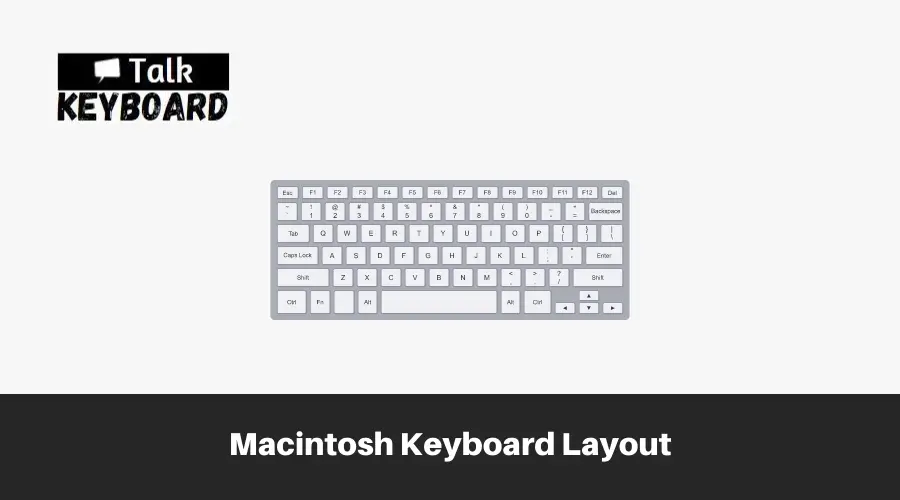The Macintosh keyboard layout, a distinctive feature of Apple’s computers, revolutionizes how users interact with their Mac devices.
This layout enhances productivity with its intuitive design, dedicated modifier keys, and seamless compatibility with Mac software. Also, it offers a comfortable typing experience. This keyboard layout ensures a cohesive and efficient workflow.
Whether you’re a seasoned Mac user or transitioning from another platform, the Macintosh keyboard layout provides seamless integration between users and their Mac experience.

What is a Macintosh keyboard layout?
The Macintosh layout for keyboard refers to the standardized arrangement of keys on Apple’s Macintosh computers. It consists of various keys that facilitate typing, navigating, and executing commands.
The layout features a QWERTY arrangement, with the alphabet keys in a familiar pattern. In addition to the standard keys, it includes special keys like Command, Option, Control, and Shift. Functionalities of these keys are specific in Macintosh OS.
Apple Computer Inc., founded by Steve Jobs, Steve Wozniak, and Ronald Wayne, invented the Macintosh keyboard layout. The layout was first introduced with the original Macintosh computer in 1984 and has evolved with subsequent Macintosh models.
The Macintosh keyboard layout was designed to provide an intuitive and user-friendly typing experience for Mac users. Apple aimed to create a keyboard complementing its graphical user interface (GUI).
As a result, completing tasks becomes easier on a Macintosh computer. Dedicated modifier keys like Command and Option allow for efficient execution of keyboard shortcuts and system commands.
The primary reason behind inventing the Macintosh keyboard layout was to offer a cohesive and seamless user experience. Apple wanted to differentiate its computers by providing a distinct keyboard layout that integrated well with its graphical interface.
The layout’s design prioritized ergonomics, functionality, and compatibility with Macintosh software. Thus, it ensures seamless interaction between users and the Macintosh operating system.
Overall, the Macintosh keyboard layout has become an iconic feature of Apple’s computers. Such a design contributes to the distinctive user experience that Mac users know and appreciate.
What are the Advantages and Disadvantages of Macintosh Keyboard Layout
Learning about the pros and cons gives you a better idea of the layout of the Macintosh keyboard. The layout has distinctive advantages and disadvantages. Let’s find them.
Advantages
- Enhanced Productivity: The Macintosh keyboard layout offers several features that boost productivity. Including dedicated modifier keys like Command and Option allow efficient execution of keyboard shortcuts and system commands. This enables users to perform tasks quickly and easily, saving time and increasing efficiency.
- Intuitive Design: The layout’s design is intuitive and user-friendly. The placement of keys follows a logical pattern, making it easier for users to locate and type characters. The arrangement of special keys, such as Control and Shift, allows seamless navigation and text manipulation. Thus, it enhances the overall typing experience.
- Compatibility with Mac Software: The Macintosh keyboard layout is specifically designed to work seamlessly with Macintosh software. This ensures that all the necessary keys for executing commands and accessing features are readily available. Mac users can effortlessly interact with applications and perform actions without complex configurations or additional software.
- Ergonomics and Comfort: The layout’s design considers ergonomics and user comfort. The placement of keys is optimized for comfortable typing, reducing the strain on fingers and wrists. Macintosh keyboards’ compact and streamlined design also allows for better posture and reduces the risk of repetitive strain injuries.
- Consistency Across Mac Devices: The Macintosh keyboard layout maintains consistency across different Mac devices, regardless of the model or form factor. This means users can switch between Mac computers and still find the keys in the exact locations. It offers a sense of familiarity and ease of adaptation, particularly for users who frequently work with multiple Mac devices.
Disadvantages
- Limited Accessibility: The Macintosh keyboard layout may not be suitable for users with specific accessibility needs. The predefined key placements and limited customization options may not cater to individuals who require specialized layouts or alternative input methods. Some users may find adapting to the Macintosh keyboard layout challenging if they are accustomed to other keyboard layouts.
- Learning Curve for New Users: For individuals transitioning from other keyboard layouts, such as Windows or alternative layouts. So, there will be a learning curve to become proficient with the Macintosh keyboard layout. The arrangement of keys and specific modifier keys may initially confuse or slow down new users. However, with time and practice, most users can overcome this disadvantage.
How does it differ from other keyboard layouts?
The Macintosh keyboard layout differs from other keyboard layouts in several ways, contributing to its distinctiveness and unique user experience.
One key difference is the placement and functionality of modifier keys. Macintosh keyboards have dedicated Command (⌘) and Option (⌥) keys, whereas other layouts, like Windows, typically have Control (Ctrl) and Alt keys. The Command key is central in executing keyboard shortcuts, and system commands specific to the Macintosh operating system.
Another notable difference is the arrangement of function keys. Macintosh keyboards traditionally include a row of function keys (F1-F12) at the top, each with predefined functions like adjusting brightness, volume, and media playback.
In contrast, other keyboard layouts often prioritize function keys’ primary function, requiring additional key combinations for system controls.
The Macintosh keyboard layout distinguishes itself by placing and labeling certain symbols and characters. For instance, the @ symbol is accessed by pressing Option + 2 on a Macintosh keyboard, whereas it is often located on the Shift+2 key in other layouts. Similarly, the placement of the backslash () and tilde (~) keys may differ.
The layout also incorporates specific keys to facilitate navigation and text editing. The Command key and other keys allow for efficient selection, copying, pasting, and undoing actions. Including the Eject key on Macintosh keyboards is another distinctive feature, allowing users to eject optical discs or external drives easily.
While the layout has unique features, it’s worth noting that it shares commonalities with other keyboard layouts, such as the QWERTY arrangement of alphabet keys.
Nevertheless, these variations in key placement, functionality, and labeling contribute to the Macintosh keyboard layout’s distinctiveness, enabling users to interact seamlessly with Macintosh computers and their operating systems.
Final Words
Unleash your productivity potential with the Macintosh keyboard layout. Its intuitive design and dedicated modifier keys provide a seamless typing experience that boosts efficiency.
From professionals to creative individuals, Mac users benefit from this user-friendly layout. Why should you opt for it? It’s all about ease of use, compatibility with Mac software, and the convenience of standardized placement.
Whether you’re navigating shortcuts, editing text, or simply typing away, the Macintosh keyboard layout offers a smooth and enjoyable experience. I will enhance your workflow and make your Mac journey delightful.

I am a regular user of computer keyboards. For using keyboard face different kinds of problems and also solve it very easily. I love sharing knowledge about keyboards.
